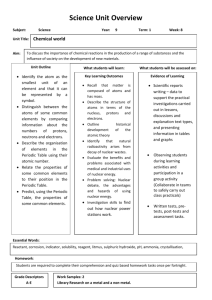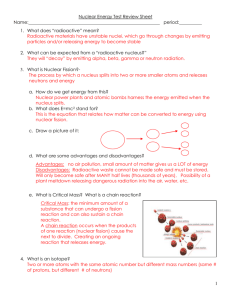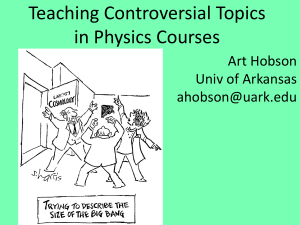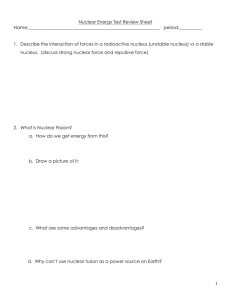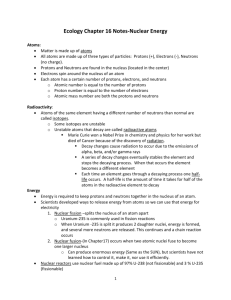Chapter 18 - An Introduction to Chemistry
advertisement
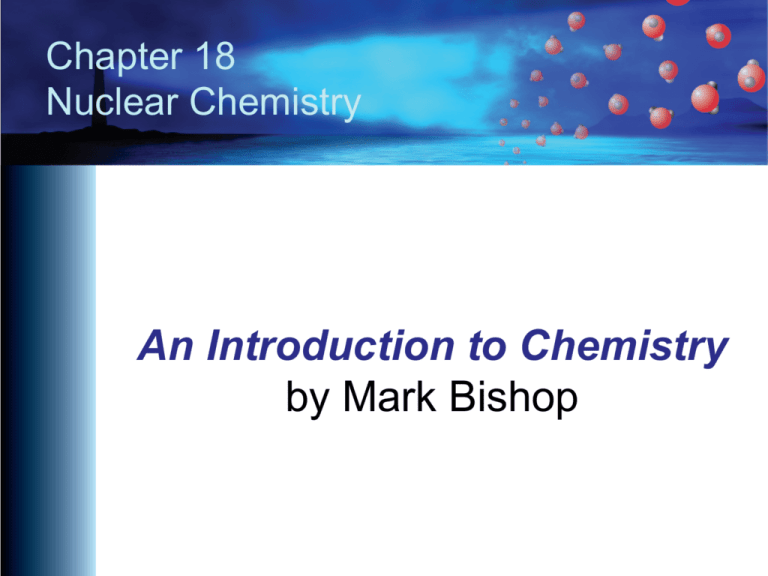
Chapter 18 Nuclear Chemistry An Introduction to Chemistry by Mark Bishop Chapter Map Nuclides • Nuclide = a particular type of nucleus, characterized by a specific atomic number and nucleon number • Nucleon number or mass number = the number of nucleons (protons and neutrons) in the nucleus of a nuclide. Nuclide Symbolism Nuclear Stability • Electrostatic force = the force that causes opposite electrical charges to attract each other. • Strong force = the force between nucleons (protons and neutrons). • Neutrons increase the attraction from the strong force without increasing electrostatic repulsion between nucleons. Band of Stability Alpha Emission Beta Emission Positron Emission Electron Capture Gamma Emission Nuclear Reactions • Nuclear reactions involve changes in the nucleus, whereas chemical reactions involve the loss, gain, and sharing of electrons. • Different isotopes of the same element may undergo very different nuclear reactions, even though an element’s isotopes all share the same chemical characteristics. Nuclear Reactions (2) • Unlike chemical reactions, the rates of nuclear reactions are unaffected by temperature, pressure, and the presence of other atoms to which the radioactive atom may be bonded. • Nuclear reactions, in general, give off much more energy than chemical reactions Nuclear Equations General Nuclear Equations Half-life = the time it takes for one-half of a sample to disappear. Radioactive Decay Series Radiation Effect on Body • Radioactive emissions ionize atoms and molecules. This also leads to free radicals (particles with unpaired electrons). H2O → H2O●+ + e− H2O●+ + H2O → H3O+ + ●OH H2O + e− → H● + OH− • These reactive particles react with important substances in the body, leading to immediate damage and delayed problems, such as cancer. Uses for Radioactive Nuclides • • • • • • Cancer radiation treatment Computer imaging techniques Radiocarbon dating Smoke detectors Food irradiation Radioactive tracers MRI Imaging • Protons act like tiny magnets. • When patients are put in the strong magnetic field, the proton magnets in their hydrogen atoms line up either with or against the field (called parallel and antiparallel). parallel + radio wave photons → anti-parallel anti-parallel → parallel + emitted energy • Emitted energy is detected by scanners placed around the patient’s body. MRI Imaging (2) • Soft tissues contain a lot of water (with a lot of hydrogen atoms) and bones do not, so the MRI process is especially useful for creating images of the soft tissues of the body. • Hydrogen atoms absorb and re-emit radio wave photons in different ways depending on their environment, so the computer analysis of the data yields images of the soft tissues. PET Scan • A solution containing a positron-emitting substance is introduced into the body. The positrons collide with electrons, and the two species annihilate each other, creating two gamma photons that move apart in opposite directions. PET Scan (2) • The gamma photons are detected and the data analyzed by a computer to yield images. • Different nuclides are used to study different parts of the body. – Fluorine-18 for bones – Glucose with carbon-11 for the brain Radiocarbon Dating [If not for radiocarbon dating,] we would still be floundering in a sea of imprecisions sometimes bred of inspired guesswork but more often of imaginative speculations. Desmond Clark, Anthropologist • Dating to about 50,000 years • Natural carbon is 98.89% carbon-12, 1.11% carbon-13, and 0.00000000010% carbon-14, which come from Radiocarbon Dating (2) • Carbon-14 is oxidized to CO2, which is then converted into substances in plants, which are then eaten by animals. • Carbon-14 is a beta emitter with a half-life of 5730 years (±40 years), so as soon as it becomes part of a plant or animal, it begins to disappear. Radiocarbon Dating (3) • When alive, intake of 14C balances the decay, so ratio of 14C to 12C remains constant at about 1 in 1,000,000,000,000. • When the plant or animal dies, it stops taking in fresh carbon, but the 14C it contains continues to decay. Thus the ratio of 14C to 12C drops steadily. • The 14C/12C ratio in the sample is used to calculate its age. Radiocarbon Dating (4) • Assuming that the 14C/12C ratio has been constant over time, if the 14C/12C ratio in a sample is one-half of the ratio found in the air today, the object would be about 5730 years old. A 14C/12C ratio of one-fourth of the ratio found in the air today would date it as 11,460 years old (2 half-lives), etc. • It’s not that simple…the percentage of 14C in the air varies due to factors such as volcanoes and natural variations in cosmic radiation. Radiocarbon Dating (5) • Tree rings show that the 14C/12C ratio has varied by about ±5% over the last 1500 years. • Very old trees, such as the bristlecone pines in California, yield calibration curves for radiocarbon dating to about 10,000 years. • These calibration curves are now used to get more precise dates for objects. Nuclear Energy • Binding energy = the amount of energy released when a nucleus is formed. • Binding energy per nucleon generally increases from small atoms to atoms with a mass number around 56. Thus fusing small atoms to form medium-sized atoms (nuclear fusion) releases energy. • Binding energy per nucleon generally decreases from atoms with a mass number around 56 to larger atoms. Thus splitting large atoms to form medium-sized atoms (nuclear fission) also releases energy. Binding Energy per Nucleon Nuclear Fission Chain Reaction Nuclear Power Plant Nuclear Power Plant (2) • Fission reactions provide heat, which is used to boil water to create steam, which turns a steam turbine to generate electricity. • To get a sustained chain reaction, the percentage of 235U must be increased to about 3%, in part because the unfissionable 238U absorbs too many neutrons. Nuclear Power Plant (3) • Fuel rods – A typical 1000-megawatt power plant will have from 90,000 to 100,000 kg of enriched fuel packed in 100 to 200 zirconium rods about 4 meters long. • Moderator slows neutrons – 235U atoms are more likely to absorb slow neutrons. – Can be water Nuclear Power Plant (4) • Control Rods – Substances, such as cadmium or boron, absorb neutrons. – Control rate of chain reaction – Dropped at first sign of trouble to stop fission reaction Nuclear Fusion Powers the Sun
